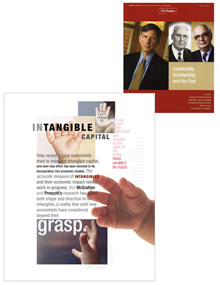 Theories abound regarding the causes and persistence of the Great Depression in the United States (and elsewhere—see Great Depressions of the Twentieth Century). Most of these theories focus on structural issues, such as misguided legislation that impeded labor markets, or monetary matters, such as the Fed raising interest rates when it should have loosened credit markets by providing liquidity.
Theories abound regarding the causes and persistence of the Great Depression in the United States (and elsewhere—see Great Depressions of the Twentieth Century). Most of these theories focus on structural issues, such as misguided legislation that impeded labor markets, or monetary matters, such as the Fed raising interest rates when it should have loosened credit markets by providing liquidity.
By contrast, little attention is paid to fiscal policy because economists generally hold that empirically it played a minor role, and theoretically it would have had little influence. A 1992 paper by Christina Romer, now chair of the President’s Council of Economic Advisers, argued the empirical case. Government spending rose little relative to GDP during the Depression years, she showed, and very few households paid taxes. On the theoretical side, Harold Cole at the University of Pennsylvania and Lee Ohanian at UCLA wrote in 1999 that neoclassical models find that increased taxation of capital during Depression years had little impact.
But a recent working paper by Minneapolis Fed monetary adviser Ellen McGrattan challenges this view that all fiscal policies had little impact (“Capital Taxation During the U.S. Great Depression,” WP670, April 2009). Specifically, McGrattan finds that Cole and Ohanian’s conclusion rests critically on their assumption that only profits, not other types of capital income, were taxed.
“The key policy change,” writes McGrattan, “was not the taxation of profits but the taxation of dividends” (emphasis added). According to McGrattan’s calculations, effective tax rates on dividends ranged from a low of 9.2 percent to a peak of 30.1 percent between 1929 and 1939, while profit tax rates varied far less, from 11.9 percent to 21.2 percent. With an expectation of higher taxes on dividends, McGrattan explains, households are likely to invest less because effective rates of return are falling. Equity values will also drop.
And indeed, using her calculated dividend tax rates in the same neoclassical model that Cole and Ohanian employed, McGrattan shows that “higher effective tax rates on dividends, consistent with the pattern of U.S. rates in the 1930s, lead to dramatic declines in investment and equity values.”
She then extends the analysis by distinguishing between tangible capital (like machinery and desks) and intangible capital (advertising and trademarks). The distinction is important because the U.S. tax code allows owners to consider the latter a nontaxable expense, so an increase in dividend tax rates will motivate owners to shift toward intangible capital accumulation. The important role of intangible capital is central in earlier McGrattan research, including a body of research with Nobel laureate Edward Prescott, a Minneapolis Fed senior monetary adviser. (See “The Untouchables,” in the December 2005 Region.)
 With intangible capital included, the effect is confirmed and amplified. McGrattan’s complete model (a standard growth framework with uncertainty, dividend tax rates and intangible capital) shows declines in investment, GDP and per capita hours worked that closely mirror actual U.S. data in the 1929-33 period. By 1933, U.S. GDP, for instance, had fallen to 65 percent of its 1929 level in actual data; the model predicts a fall to 78 percent; U.S. hours worked per capita fell to 73 percent in actual data compared to a model drop to 80 percent.
With intangible capital included, the effect is confirmed and amplified. McGrattan’s complete model (a standard growth framework with uncertainty, dividend tax rates and intangible capital) shows declines in investment, GDP and per capita hours worked that closely mirror actual U.S. data in the 1929-33 period. By 1933, U.S. GDP, for instance, had fallen to 65 percent of its 1929 level in actual data; the model predicts a fall to 78 percent; U.S. hours worked per capita fell to 73 percent in actual data compared to a model drop to 80 percent.
These findings suggest, then, that contrary to conventional wisdom, capital taxation was “a potentially important contributor to the U.S. contraction,” writes McGrattan. “Tax rates on dividends rose significantly during the decade and, when fed into the standard growth model, imply a large drop in investment and equity values.” If intangible investment is included, “the effects are even larger.”
McGrattan cautions that this is work in progress. Her model doesn’t account for diversity among economic households, when in reality the U.S. population differed widely in its exposure to capital income derived from business activity. Also, she notes, taxation of undistributed profits and capital gains needs to be better modeled in future analysis. Still, McGrattan has shown that the prevalent assumption of fiscal policy having little impact during the U.S. Great Depression is highly questionable—opening a new avenue for understanding why economies grow and collapse.





